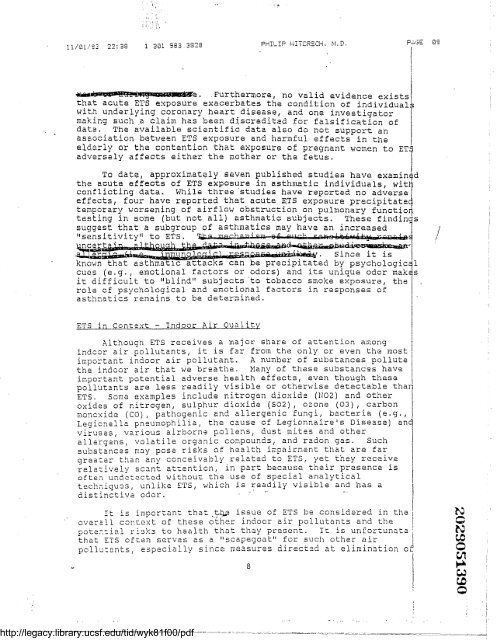ets exposure, lung cancer - Legacy Tobacco Documents Library
ets exposure, lung cancer - Legacy Tobacco Documents Library
ets exposure, lung cancer - Legacy Tobacco Documents Library
You also want an ePaper? Increase the reach of your titles
YUMPU automatically turns print PDFs into web optimized ePapers that Google loves.
11/91/93 22 :38 1 301 983 38^_S<br />
PHILIP<br />
WITCFECH . ht . D .<br />
WMAN_' e . Furthermore, no valid evidence existsi<br />
that acute ETS <strong>exposure</strong> exacerbates the condition of individual<br />
witri underlying coronary heart disease, and one investigator<br />
making such a claim has been discredited for falsification of<br />
data . The available scientific data also do not suppor-t an<br />
association between ETS <strong>exposure</strong> and harmful effects in the<br />
elderly or the contention that <strong>exposure</strong> of pregnant women to Ei<br />
adversely affects either the mother or the fetus .<br />
To date, approximately seven published studies have examinqd<br />
the acute effects of ETS <strong>exposure</strong> in asthmatic individuals, Nit<br />
conflicting data . While three'studies have reported no adverse<br />
effects, four have reported that acute US <strong>exposure</strong> precipitate<br />
temporary worsening of airflow obstruction on pulmonary functio<br />
testing in some (but not all) asthmatic subjects . These findings<br />
suggest that a subgroup of asthmatics may have an increased<br />
"sensitivity" to ETS . `i,kgi<br />
ncerta i n a 1 t hntirrh t rLata ._i._r.: t~a~co~_~~<br />
Since it is<br />
known that asthma lc attacks can be precipitated by psychologic~l<br />
cues (e .g ., emotional factors or odors) and its uniau.e odor mak s<br />
it difficult to "blind" sub7ects 'to tobacco smoke ex.posure, the<br />
role of psychological and emotional factors in responses of<br />
asthratics remains to be determined .<br />
.<br />
ETS in Context - Indoor Air OualitY I<br />
Although ETS receives a major share of attention among<br />
indcor air pollutants, it is far from the only or even the raostl<br />
important indoor air pollutant . A number of substances pollute~<br />
the indoor air that we breathe . Many of these substances have<br />
important potential adverse health effects, even though these<br />
pollutants are less readily visible or otherwise detectable than<br />
ETS, Some examples include nitrogen dioxide (2102) and other<br />
oxides of nitrogen, sulphur dioxide (S02), ozone (03), carbon<br />
moncxide (CQ), pathogenic and allergenic fungi, bacteria (e .g .,<br />
Leaicn=lla pneumophilia, the cause of Legionnaire's Disease) anc~<br />
viruses, various airborne pollens, dust mites and othe Ir<br />
allergens, volatile organic compounds, and radon gas . Such<br />
substances may pose risks of health impairment that are far<br />
grea ;.er than any conceivably related to ETS, yet they receive<br />
rela :.ively scant atzenticn, in part because their presence is<br />
often undetected without the use of special analytical<br />
techniqu^s, unlike ETS, which is readily visible and has a<br />
distinctiva odor .<br />
Tt is important that ti4: issue of ETS be considered in the! ~<br />
overall cot .text of these other indoor air pollutants and tha ~ G<br />
pot4 ~. :.iz1 h risks that to heal'- they ~ present . It is unLortunata ~ N<br />
that ETS often serves as a"scapegoat" for such other air ~ ~<br />
pollutants, especially since measures directed at elimination of ~<br />
http://legacy.library.ucsf.edu/tid/wyk81f00/pdf<br />
~<br />
i<br />
/<br />
~<br />
~<br />
, ~

















